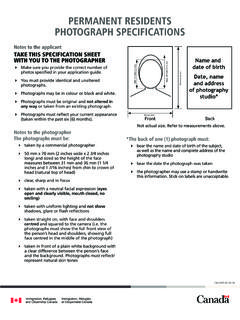Transcription of Convention Signed at Washington, D.C. on September …
1 UNITED STATES - canada INCOME TAX CONVENTIONC onvention Signed at Washington, on September 26,1980;Protocol Signed at Ottawa June 14, 1983;Protocol Signed at Washington, , March 28,1984;Ratification Advised by the Senate of the United States of America on June 28, 1984;Entered into Force August 16, EFFECTIVE DATE UNDER ARTICLE XXX: 1 JANUARY 1985 TABLE OF ARTICLESARTICLE I------------------------------Personal ScopeARTICLE II-----------------------------Taxes CoveredARTICLE III----------------------------General DefinitionsARTICLE IV----------------------------ResidenceA RTICLE V-----------------------------Permanent EstablishmentARTICLE VI----------------------------Income from Real PropertyARTICLE VII---------------------------Business ProfitsARTICLE VIII--------------------------Transporta tionARTICLE IX----------------------------Related PersonsARTICLE
2 X-----------------------------DividendsA RTICLE XI----------------------------InterestAR TICLE XII---------------------------RoyaltiesA RTICLE XIII--------------------------GainsARTIC LE XIV--------------------------Independent Personal ServicesARTICLE XV---------------------------Dependent Personal ServicesARTICLE XVI--------------------------Artistes and AthletesARTICLE XVII-------------------------Withholding of Taxes in Respect of IndependentPersonal ServicesARTICLE XVIII------------------------Pensions and AnnuitiesARTICLE XIX--------------------------Government ServiceARTICLE XX --------------------------StudentsARTICL E XXI--------------------------Exempt OrganizationsARTICLE XXII-------------------------Other IncomeARTICLE XXIII------------------------CapitalARTI CLE XXIV------------------------Elimination of Double TaxationARTICLE XXV-------------------------Non-Discrimi nationARTICLE XXVI------------------------Mutual Agreement ProcedureARTICLE XXVII-----------------------Exchange of InformationARTICLE XXVIII----------------------Diplomatic Agents and Consular
3 OfficersARTICLE XXIX------------------------Miscellaneou s RulesARTICLE XXX-------------------------Entry into ForceARTICLE XXXI------------------------TerminationN otes of Exchange----------------------of 26 September , 1980 Letter of Submittal----------------------of 16 October, 1980 Letter of Transmittal--------------------of 12 November, 1980 Protocol 1---------------------------------of 14 June, 1983 Notes of Exchange-(Protocol 1)-------of 14 June, 1983 Letter of Submittal-(Protocol 1)-------of 2 September , 1983 Letter of Transmittal-(Protocol 1)-----of 21 September , 1983 Protocol 2---------------------------------of 28 March, 1984 Letter of Submittal-(Protocol 2--------of 2 April, 1984 Letter of Transmittal-(Protocol 2)-----of 18 April, 1984 Protocol 3---------------------------------of 17 March, 1995 Letter of Submittal-(Protocol 3)-------of 12 April, 1995 Letter of Transmittal-(Protocol 3)-----of 24 April, 1995 Protocol 4---------------------------------of 29 July, 1997 Letter of Submittal-(Protocol 4))
4 -------of 12 August, 1997 Letter of Transmittal-(Protocol 4)-----of 23 September , 1997 The Saving Clause --------------------Paragraph 2 of Article XXIXCONVENTION WITH canada WITH RESPECTTO TAXES ON INCOME AND CAPITALMESSAGEFROMTHE PRESIDENT OF THE UNITED STATESTRANSMITTINGA Convention BETWEEN THE UNITED STATES OF AMERICA AND canada WITHRESPECT TO TAXES ON INCOME AND CAPITAL, Signed AT WASHINGTON ONSEPTEMBER 26, 1980, WITH A RELATED EXCHANGE OF NOTESLETTER OF SUBMITTALDEPARTMENT OF STATE,Washington, October 16, PRESIDENT,The White House. THE PRESIDENT: I have the honor to submit to you, with a view to its transmission to the Senatefor advice and consent to ratification, a Convention between the United States of America and Canadawith respect to Taxes on Income and Capital (the Convention ), Signed at Washington on September 26,1980, and a related exchange of notes Signed on the same day.
5 The existing income tax Convention with canada , which was Signed in 1942 and amended forsupplementary conventions in 1950, 1956 and 1966, is the second oldest United States tax conventionin force. The new Convention revises the existing Convention by accommodating changes in UnitedStates and canadian law, with particular reference to canada 's 1971 tax reform, as well as changes intreaty policy. The Convention is based, in general, on the United States and OECD model conventions. Itdeviates from the models, however, in a number of important respects in order to take account ofparticular features of canadian law and its interaction with United States law, the unique economicrelationship between the United States and canada , and the provisions of the existing Convention .
6 Like the existing Convention , the new Convention provides that the business profits of a resident ofone Contracting State will not be subject to tax by the other State except to the extent that they areattributable to a permanent establishment which the resident has in the other State. The definition of apermanent establishment in the new Convention is more comprehensive than that in the existingconvention and is very similar to the definition in the United States model. The Convention follows the normal practice of providing reciprocal exemption for internationalshipping and air transport income.
7 It goes beyond the model, however, by exempting on a reciprocalbasis, as in the existing Convention , income from the international operation of motor vehicles. It alsoadds an exemption for railroad operating income and a limited exemption for income from the rental ofrailway equipment, motor vehicles, trailers, and containers. The Convention establishes maximum reciprocal rates of withholding at source for dividends,interest. and royalties. Although the rates exceed those in the United States model for several types ofincome, there are a number of significant reductions in withholding rates in comparison with the existingconvention.
8 Portfolio dividends remain subject to a maximum 15 percent rate of tax at source. The maximumrate of tax at source on direct investment dividends is, however, reduced to 10 percent, from the 15percent rate provided in the existing Convention . This reduced rate also applies to the canadian tax onbranch profits, presently being imposed at a rate of 15 percent. Unlike the existing Convention , theConvention preserves for the United States its right to impose tax on dividends paid by a Canadiancorporation where at least 50 percent of the gross income of that corporation is attributable to a UnitedStates permanent establishment of that corporation.
9 As in the existing Convention , the maximum rate of withholding tax at source on interest is set at 15percent. However, the new Convention provides several exceptions to that rule under which interest isexempt at source. Interest derived, guaranteed, or insured by a Contracting State, political subdivision,local authority, or instrumentality is exempt at source, as is interest paid by an entity not subject to tax inthe source State and interest on trade credits between persons dealing at arm's length. Artistic royalties, other than motion picture royalties, continue to be exempt at source.
10 All otherroyalties are subject to a maximum source country tax rate of 10 percent, as compared to 15 percentunder the existing Convention . Under the existing Convention gains from the sale or exchange of capital assets are generally exemptfrom tax in the source State. The new Convention introduces a number of important modifications tothat rule. As in the United States model, gains from the alienation of real property and property formingpart of a permanent establishment may be taxed where the property or permanent establishment issituated.












